Impossible Foods came out with their new burger, the Impossible Burger 2.0 this year, with a “better” formula for their version of a “veggie” burger. But their veggie burger is more than just another attempt at beans/ mushrooms/ grains/ and beet juice to make it look red. Their burger was designed with the help of modern biochemistry and molecular genetics to look like, and act like a burger – right down to the real red stuff coming out.
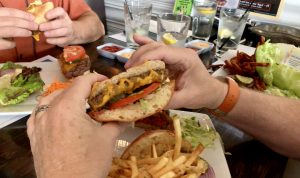
It does look like a burger
To Be Fair:
There are some vegetable burgers that are delicious, but most fail. My favorite vegetable burger comes from Hillstone, and in fact, compared to most burgers, I like this one a lot.
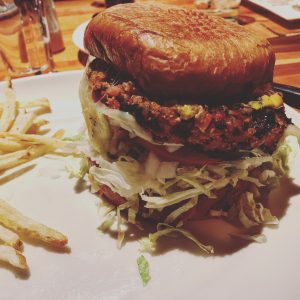
Around the country Hillstone’s Vegetable burger is the best
Wherever there is a Hillstone Restaurant (formerly Houstons), this vegetable burger gets amazing reviews. It is delicious. It does not look like a burger, but its flavor is delicious.
So why does The Impossible 2.0 veggie burger attracting so much attention?
The purpose of Impossible Foods was to make plant based substitutes for meat and dairy products. Their found, Patrick Brown, a vegetarian, felt strongly that industrial animal agriculture is a severe agricultural problem. But getting people to eat vegetables just because of that moral argument doesn’t work if you don’t have a product that is delicious.
Brown left his dream job, as a Professor of Biochemistry at Stanford University to start Impossible Foods in 2011. The idea of making a veggie burger look like and taste like a regular burger has been akin to the pursuit of the Holy Grail – almost mythical in nature. But Brown had a better idea: breakdown the plant proteins to a molecular level and use those proteins, carbohydrates, and fats to mimic the animal protein. As only a molecular biochemist could do, he successfully began to determine the various components of the hamburger and find substitutes for those components in plants proteins.
This idea gained attention from venture capitalists, including Bill Gates, and to date Impossible Burgers has received over 372 million dollars in funding.
Impossible Burger 1.0 launched in July 2016. While this burger generated enthusiasm, it wasn’t enough and what was missing, according to Brown, was heme – that component of blood and muscle tissue that carries oxygen and nutrients – the molecule that makes blood red. It turns out that plants also use hemoglobin, and they used a legohemoglobin found in the roots of soy plants. In order to make large quantities they added this protein to yeast to produce a GMO that could make vast quantities of heme. This process does give the anti-GMO crowd pause, but there has been zero evidence that any GMO is unsafe.
By adding the heme as well as redoing the original formula to better mimic the texture and taste of meat they used the new heme, potato proteins, and coconut oil as the basis for their new burger.
How Does It Taste
For any burger lover, the real question is how does it taste. For that, I urge you to listen to our podcast where Evo Terra and I taste the Impossible Burger side-by-side with the burger made from Neiman Ranch hamburger at our favorite local burger joint called DeLux Burgers in Phoenix, AZ. Here is a hint: since having this burger I have had four more in less than a month.
Nutritional Elements
Here is the standard label from a 4 ounce patty from Impossible Burger 2.0
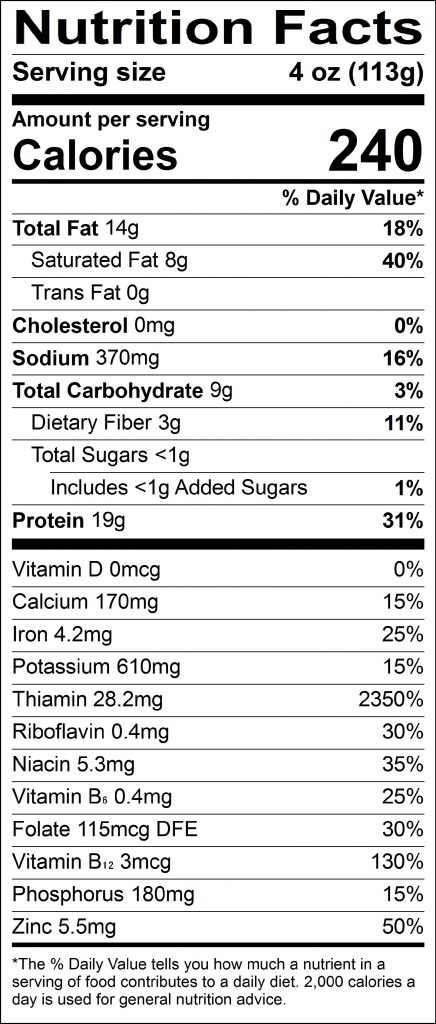
Compare that with Niman Ranch – the other burger we ate that day:
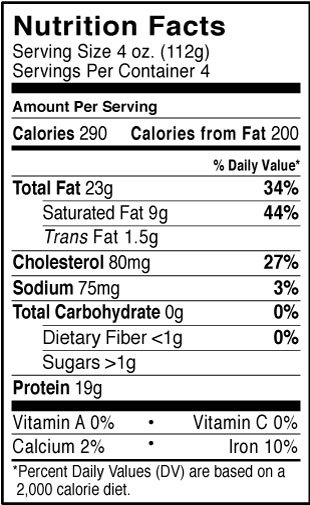
As we look at these side by side both give 19 grams of protein. The Impossible Burger, unlike most veggie burgers, is a complete protein, the same type of complete protein you would find in meat. They are equal with regard to that. There is more sodium in the Impossible burger. There is more fat in the Niman Ranch burger including some trans-fat which is normally found in nature. However, the Impossible Burger 2.0 has less fat (19 grams vs 23 grams) and NO trans-fat, and slightly less saturated fat.
In terms of other elements, the Impossible Burger has more iron, calcium, B12, B1, and etc.
The Impossible Burger 2.0 is also 50 to 100 less calories than a regular burger.
Hillstone’s burger is also 290 calories with 13 grams of protein, 45 grams of carbs, and 4 grams of fat. Overall, a healthier mix of nutrients and it is larger and keeps one satisfied much longer.
Most plant proteins are incomplete – that is, they do not contain all the essential amino acids. It turns out that Impossible 2.0 does. They use soy protein, that has the same high quality protein, meaning a balanced amount of the essential amino acids. Soy protein is actually the only plant-based protein that the FDA recognizes as a healthful replacement for animal protein. The way this is quantified is by PDCAAS score. The soy protein concentrate that we use in the Impossible Burger has a PDCAAS score of 0.99, while beef from cows has a PDCAAS score of 0.92. Here is a link to a blog post from Impossible Foods’ VP of Health and Nutrition, Dr. Sue Klapholz, that goes into much more detail about the health facts of soy protein:
https://medium.com/impossible-foods/soy-facts-myths-and-why-its-in-our-new-recipe-12815b4997cf
The long-term goal of Impossible Foods is to accelerate the switch to a sustainable food system and offer delicious options to consumers all over the globe. They started with the Impossible Burger and do plan to expand to a range of “delicious” products, including pork, chicken, fish and dairy. Impossible Foods’ mission is to dramatically reduce the amount of land, water and energy required to support the world population by 2035.
Impossible Foods goal is to produce in every country with agriculture and food systems, but they haven’t disclosed any announcements about an international launch facility. Their first production facility in Oakland, California opened in 2017 and soon will be able to produce up to 2 million pounds of Impossible Burger per month. In addition, they are working diligently to find the right option and location for their next production facility that will minimize their environmental impact and maximize product availability.
As Impossible Foods increase production capacity, they will be able to supply Impossible product to retail outlets. They have announced that they will be entering retail in the U.S. later in 2019, but have not shared specifics beyond that. Their goal is to be mainstream, mass-market – and available anywhere you can find meat from animals.
More than half of the ice free land on Earth and more than one-quarter of Earth’s freshwater is used to raise livestock and their food, making animal farming a cause of species extinction and global warming. Reducing the use of animals for food, Dr. Brown figured, would liberate land and water, mitigate climate change and make people healthier.
With his background in biochemistry and a strong sense of urgency, he brought together a team of scientists to figure out how to create meat, dairy, and fish that would outcompete their animal-based counterparts in every way that was important to consumers. After raising a seed round with Khosla Ventures, Pat Brown founded Impossible Foods in Menlo Park, and later moved the headquarters to Redwood City.
Impossible Foods announced earlier this year at CES that they are now starting to work on a steak, but they have not yet announced a launch timeframe, pricing or additional information.
The Environment
Even though Niman Ranch is very careful with their cattle, they do have an element of factory farming to their cattle. While complete grass-fed or pasture raised cattle are a net positive for the environment, even Niman does not have the property to raise beef in this manner. The Impossible Burger uses 95% less land, 74% less water, and emits 87% less greenhouse gas than the standard burger.
Who Should Eat This Burger
If you are the omnivore that wants to do something for your environment, this is a good product for you.
It is also Kosher certified as well as Halal certified.
The new Impossible Burger 2.0 is gluten free.
It would not be “certified” as organic.
It does use GMO – however, as many know, this should not be an issue with this or any food product. We will have an entire podcast devoted to GMO at a later time.
This is my kind of burger. I can eat it and not feel guilty about the environment. It is not always easy to be out and get a “grass fed” burger, but now that this burger can be found in a wide variety of establishments – Red Robin, White Castle, some Burger Kings, Hop Daddy, and DeLux (my favorite burger joint) – I like it.
But is it as good as Hillstone’s vegetable burger? Not one bit. If I had a choice I would eat Hillstone’s burger.
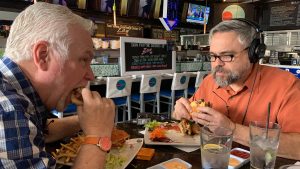
Evo Terra and I try the Impossible Burger
References:
“The Role of Animal Agriculture in a Sustainable 21 st Century Global Food System: A Scoping Workshop” (PDF). dels.nas.edu. “GRAS Notification for Soybean Leghemoglobin Protein Derived from Pichia pastoris” (PDF).
